


xxxxxThe French painter Eugène Delacroix was trained as a classical artist, but turned to romanticism on seeing Géricault’s The Raft of the Medusa. His first dramatic painting, The Barque of Dante, was well received, but his next works, notably The Massacre of Chios of 1824, and The Death of Sardanapalus (1827), based on Byron’s play, alarmed the critics by their bold colours and their violence and eroticism. In 1830, however, his Liberty Leading the People, a glorification of the July Revolution of that year, brought him back in favour, and a visit to Morocco in 1832 heightened his love of bright colours and exotic subjects. He spent the last thirty years of his life painting vast decorative schemes in public and church buildings throughout Paris, but his earlier work made him the leader of the French romantic movement, and the arch rival to the neo-
EUGÈNE DELACROIX 1798 -
(G3b, G3c, G4, W4, Va, Vb)
Acknowledgements
Delacroix: Self-
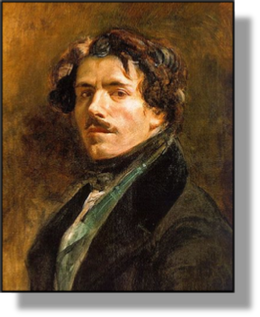 xxxxxEugène Delacroix, the supreme artist of the French romantic movement, was given a classical training. Born in Paris, he attended the École des Beaux Arts as from 1815, and underwent a rigid regime of formal teaching, making a close study of Greek and Roman sculpture, and confining his subject matter to mythology and ancient history. However, one of his fellow students was the young Théodore Géricault, and, as we have seen, he had very different ideas in mind. In 1818 Delacroix watched him at work on his huge painting The Raft of the Medusa, a dramatic scene from a contemporary shipwreck, and this proved a turning point. He was so excited at what he saw, he later recalled, that on leaving Géricault’s studio he ran off “like a madman”, not stopping until he reached his lodgings.
xxxxxEugène Delacroix, the supreme artist of the French romantic movement, was given a classical training. Born in Paris, he attended the École des Beaux Arts as from 1815, and underwent a rigid regime of formal teaching, making a close study of Greek and Roman sculpture, and confining his subject matter to mythology and ancient history. However, one of his fellow students was the young Théodore Géricault, and, as we have seen, he had very different ideas in mind. In 1818 Delacroix watched him at work on his huge painting The Raft of the Medusa, a dramatic scene from a contemporary shipwreck, and this proved a turning point. He was so excited at what he saw, he later recalled, that on leaving Géricault’s studio he ran off “like a madman”, not stopping until he reached his lodgings.
xxxxxThe immediate result of this artistic conversion was seen in 1822 when Delacroix exhibited his first major work, a very large painting entitled The Barque of Dante, a subject taken from the Italian writer’s Inferno. A powerful, extremely dramatic work, it possessed the strong colours of Rubens and the rounded modelling of Michelangelo, but its theme was a far cry from classical antiquity. Nonetheless, it caused a sensation, was a huge success, and was bought by the state, the ultimate mark of approval. Delacroix promptly left his formal training and, brimming with confidence, turned like Géricault, to the portrayal of a contemporary event – The Massacre of Chios (1824) from the Greek War of Independence. This was a moving portrayal of a bloody, gruesome incident, but it proved a step 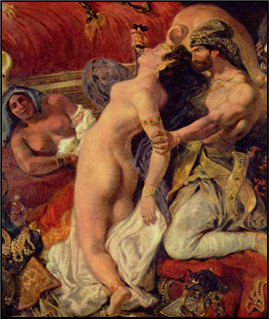 too far for the conventionalists. The classical artist Gros, for example, who had applauded Delacroix’s first exhibit, referred to it as the “massacre of painting”.
too far for the conventionalists. The classical artist Gros, for example, who had applauded Delacroix’s first exhibit, referred to it as the “massacre of painting”.
xxxxxBut Delacroix was not without friends. Highly cultivated, witty and charming, he came to know a large number of writers and musicians who sought to use their imagination and emotions, including the composer Hector Berlioz and the writer Victor Hugo. He was also inspired by Shakespeare’s Hamlet and poems by Lord Byron, and in 1825 visited England for a few months. Here, through his friendship with the English painter Richard Parkes Bonington -
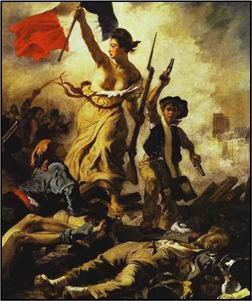 xxxxxOn his return to France he worked on his third salon picture, The Death of Sardanapalus, exhibited in 1827 (detail illustrated above). Based very loosely on Byron’s play of that name, it was a frenzied scene, full of violence and eroticism, and awash with brilliant colour and rounded forms. Not surprisingly, it horrified the critics and shocked the art world in general. He fell into disfavour, and would probably have remained so but for the coming of the July Revolution of 1830. His Liberty Leading the People (detail illustrated), a rousing scene on the barricades with the tricolour held high, proved an unqualified success. Though romantic in the extreme, and in stark contrast to the muted tones and cool detachment of the neo-
xxxxxOn his return to France he worked on his third salon picture, The Death of Sardanapalus, exhibited in 1827 (detail illustrated above). Based very loosely on Byron’s play of that name, it was a frenzied scene, full of violence and eroticism, and awash with brilliant colour and rounded forms. Not surprisingly, it horrified the critics and shocked the art world in general. He fell into disfavour, and would probably have remained so but for the coming of the July Revolution of 1830. His Liberty Leading the People (detail illustrated), a rousing scene on the barricades with the tricolour held high, proved an unqualified success. Though romantic in the extreme, and in stark contrast to the muted tones and cool detachment of the neo-
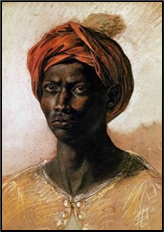
xxxxxThere followed, in 1832, a somewhat unexpected trip to North Africa, when he tagged on to an official visit to the Sultan of Morocco. Delacroix was utterly captivated by all that he saw, and made hundreds of drawings and water-
xxxxxThe last three decades of his life were largely devoted to painting vast decorative schemes, both walls and ceilings, in government buildings and churches throughout Paris, though he did continue to produce a large number of small canvases and contribute to papers and magazines. Among the buildings he decorated were the Salon du Roi in the Bourbon Palace, the Library at Luxembourg Palace, and the Chapel of the Holy Angels in the Church of Saint-
xxxxxAnd slowly during this period he withdrew from society, becoming very much a loner, preoccupied with his work and troubled by bouts of ill-
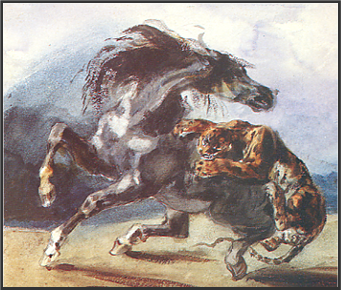
xxxxxDelacroix saw a fertile imagination as the essential gift of any painter, and emotion as the means of firing that imagination with the mood required, be it fear, passion, pity or any other feeling. And the means of conveying this to canvass was by rich colour, tonal effects, and expressive brushwork. “When the tones are right,” he wrote, “the lines draw themselves.” This is to be seen in all his studio work, and in none more so than in his watercolour Horse Attacked by a Tiger of 1825 (illustrated). Delacroix was fascinated by wild, exotic animals, and this work, so full of movement and ferocity, has all the ingredients of his romantic style. And some of his later brushwork, with its short, separate strokes in contrasting colour, had an impact on the technique of future artists, such as the impressionist painter Claude Monet and the post-
xxxxxOn his death, his studio was found to contain some 9,000 separate items -
xxxxxAmong his other major works were The Execution of the Doge Marino Faliero of 1826, Horses Emerging from the Sea of 1860, and the three paintings shown below (left to right): The Jewish Wedding in Morocco, Greece on the Ruins of Missolonghi, and The Entry of the Crusaders into Constantinople. Portraits of his friends included Chopin and the Italian violinist virtuoso Nicolò Paganini.
Including:
Richard Parkes
Bonington

G4-
xxxxxThe English oil and water-
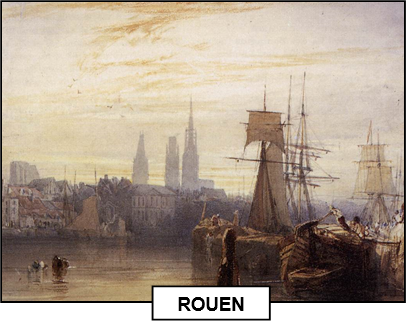 xxxxxThe English landscape painter Richard Parkes Bonington (1802-
xxxxxThe English landscape painter Richard Parkes Bonington (1802-
xxxxxHis seascapes and landscapes in water and oil, influenced respectively by the English artists Thomas Girtin and John Constable, were remarkable for their realistic atmosphere, and added markedly to the French romantic movement. Painted directly from life, his use of clear, gem-
xxxxxNot long after arriving in Paris he became a close friend of Delacroix. Both committed romantics, they shared an interest in English literature, particularly works by William Shakespeare, Lord Byron and Sir Walter Scott, and they made a special study of Constable’s technique. It was Bonington who arranged Delacroix’s visit to England in 1825. For the most part he worked in France, making tours of Normandy, Picardy and Flanders, but he paid a visit to Venice in 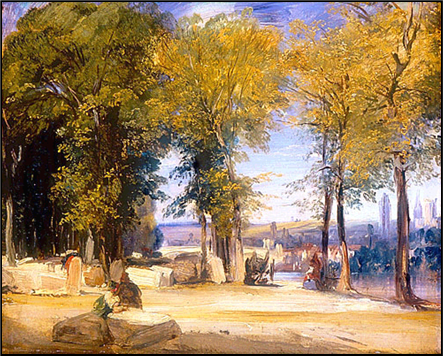 1826, and painted some views of the city. Just two years later, on returning to London, he died of consumption at the age of 26.
1826, and painted some views of the city. Just two years later, on returning to London, he died of consumption at the age of 26.
xxxxxHis landscapes included Normandy Coast and View of the Parterre d’Eau at Versailles, both in the Louvre, Roadside Halt, Fishermen near Boulogne, and View Near Rouen (illustrated here). Among his historical pictures, which were clearly influenced by those of Delacroix, were Henry III and the English Ambassador, Francis I and the Duchess d’Étamps, and Henry IV and the Spanish ambassador. He also excelled in lithography, and illustrated some of the works of Sir Walter Scott in this medium.
xxxxxConsidering the short span of his career, Bonington’s influence was considerable. Many contemporary French and British artists attempted to copy his technique, and his landscapes proved of particular value in the development of the Barbizon School. A leading light in the French romantic movement, he was much admired by its two major proponents Théodore Géricault and Eugène Delacroix. Illustrated here are three works showing the width of his talent: Seascape, View in Brittany, and The Doge’s Palace, Venice.

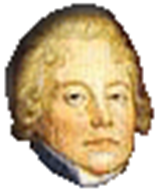
xxxxxIncidentally, it is very likely that Delacroix was the illegitimate son of the famous French statesman Charles Talleyrand, to whom he bore a close resemblance. This might well account for the help he received from the government throughout his career. Talleyrand was a close friend of the Delacroix family, and spent some time at their home when Delacroix’s father was serving abroad. ……
xxxxx…… As noted earlier, there was little love lost between Delacroix and his rival, the neo-
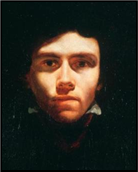
xxxxx…... Delacroix never liked the portrait produced by his friend Théodore Géricault (illustrated here). He felt that it revealed the wild side of his nature. Apparently there was some truth in that. The French poet Charles Baudelaire who, it must be said, regarded Delacroix as “the last of the great artists of the Renaissance and the first of the modern”, described him as a volcano concealed beneath a carpet of flowers!
xxxxxIncidentally, the Wallace Collection in London has 35 of his oil and water colours. Delacroix, a great admirer of his work, described each of his paintings as “a type of diamond that flatters and ravishes the eye”.



